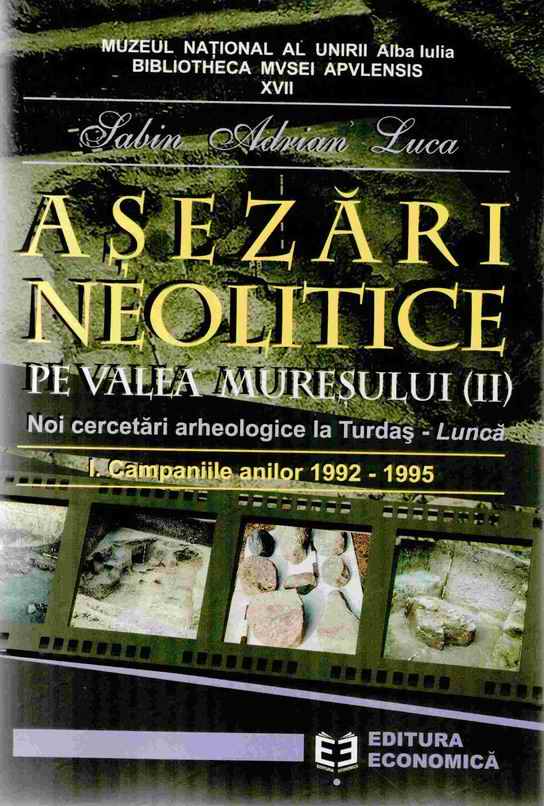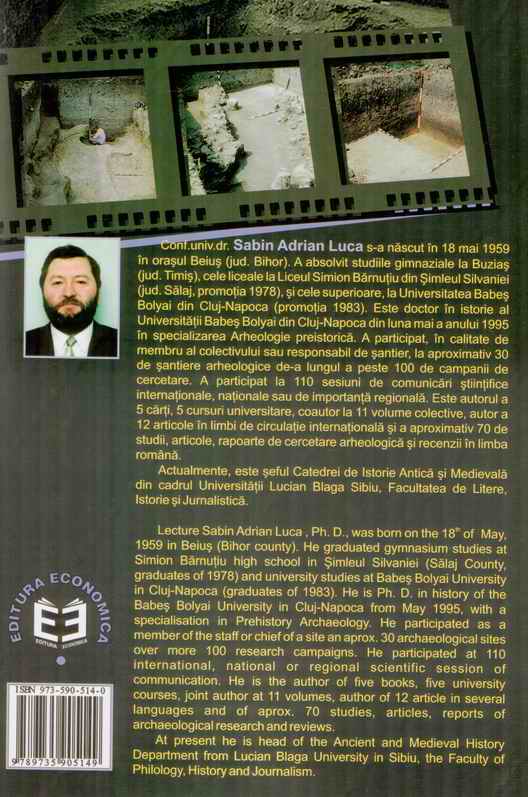| NEOLITHIC SETTLEMENTS IN THE VALLEY OF THE MUREŞ (II) NEW ARCHAEOLOGICAL RESEARSCH AT TURDAŞ–LUNCĂ, I. THE 1992–1995 CAMPAINGS. Autor: Sabin Adrian LUCA, BIBLIOTHECA MVSEI APVLENSIS XVII, ISBN 973-590-514, Editura Economică, 2001 © copyright: Sabin Adrian
Luca Prelucrare Web: Cosmin
Suciu; Powered by: Institutul pentru Cercetarea Patrimoniului Cultural
Transilvanean în Context European (IPTCE) Coperta 1 / Coperta 2 ABSTRACT Geographical environment In this chapter the author
analyses the main geo–morphological, climatic, flora and fauna
characteristics of the surrounding environment of the archaeological site of
Turdaş–Luncă. It is stressed
that the settlement lies on the southern side of an active bend of the river
Mureş and it is situated on a high terrace of the same river. Finally,
it is concluded that in this area the Mureş had the utmost special
economic importance in the development of the Neolithic and Aeneolithic
communities from here. The history of the research
The author finds out that
the settlement from Turdas in well-known in Transylvania after the year 1875
when the baroness Zsófia von Torma does some excavations at the place called
“Luncă”. Otherwise, this baroness dedicated her entire life to the study
of the archaeological material discovered in this site or in the one at
Nandru Vale, studied in 1876. The activity of this research made the site
from Turdaş become famous and this the barones Z. von Torma was awarded
with the title of Doctor Honoris Causa of the University of Cluj. In 1910, Márton Roska made
systematic excavations at Turdaş, this being given the opportunity to
process and publish the collection from Cluj. In 1940, the site was
studied by Octavian Floca and Vladimir Dumitrescu for several days and in the
1960's by Iuliu Paul. In the 1970's and 1980's Florin Draşoveanu,
Tiberiu Mariş, Gheorghe Lazarovici, Zoia Kalmar-Maxim (from Romania) and
John Nandris (from England) continued the research. The description of the systematic archaeological research The Neolithic and
Aeneolithic settlement from Turdaş is situated on the banks of the Mureş at a distance
of aprox. 250 m westwards from the last house in the village of Turdaş
and aprox. 50 m northwards the railway route Deva – Orăştie. At
present the settlement has a length of approx. 600 m alongside Mureş and
approx. 80–100 m towards the railway. The site has been devided into 3 large
areas: (plan 1): A = Central area; B = Western area; C = Eastern area.
Towards the end of the eastern area, in point D a burial tomb has been
discovered. In the central area we
have marked and excavated the areas S1/1992–1993(plans III and V;
size: 10 m length and 3–4 m breadth, in accordance with the winding of the
banks of the Mureş; the dwellings are: mudhut B1/1992; mudhut
B2/1992–1993; dwelling L1/1992 and dwelling L3/1992);
S II/1994–1995 (plan II; size: 6,40 / 4,40 m; dwellings that were discovered
are: mudhut B4/1995; dwelling L2/1994–1995 and dwelling
L4/1995) and the square excavation C3/1993 (plan IV c;
size: 3,5 / 1 m; dwelling: mudhut B3/1993). In the western area we
have marked and excavated the square excavations C1/1993 (plan
IVa; size: 4 / 3 m; a hut was discovered, belonging to the Coţofeni
culture) the square excavation C2/1993 (size: 4 / 3,5 m; a
dwelling belonging to the Petreşti culture was discovered, not
numbered), the square excavation C4/1994–1995(plan IVd; size: 4,70
/ 4,70 m; a dwelling belonging to the Petreşti culture was discovered,
not numbered) and the square excavation C5/1994–1995(size: 4,5 /
4,5 m; the Petreşti dwelling L5/1994–1995 not entirely
studied). The stratigraphy of the
site presents itself as follows: §
level I (central area; plan I, point A) belonging to the Turdaş
culture. The main archaeological grounds of the level are the mudhut B1/1992
and the mudhut B2/1992–1993. §
level II (central area)
belongs also to the Turdaş culture and has two sub-levels: - level II – inferior has the mudhuts B3/1993
and B4/1995 as most important dwellings; - level II – superior (central area; level I in the western
area) has the surface dwellings L1/1992 and L4/1995 as the most important
archaeological ground; §
level III (central area; level III from the western area) has the
surface dwellings L3/1992, L2/1994–1995 and L5/1994–1995,
belonging to the Petreşti culture, as most important architectural
grounds. In the western area (plan
l, point B) it also appears a level III, with dwellings the type of a hut,
belonging to the Coţofeni culture. In area D (plan I, point
D) it was discovered the tomb of a child who was crouched on the floor of a
deepened dwelling, headed North-South with his face towards the East. The
child must have buried at an early age (plan lVb). The description of the archaeological materials The description of the
archaeological materials is done on the cultures represented in the
settlement at Turdaş–Luncă.
A)
Turdaş culture. The main pottery categories are the fine one, the
semi-fine and customary one. The main aspects are the ones from the
drawings I–III. The most frequent ornaments are the ones in the characteristic
style of the Turdaş culture (marked belts filled with short marks).
The most interesting ornaments are made through painting in red, yellow
or white colour before burning the pottery or black-bitumen after burning
it. Some clay figurines, and a slate with marked signs on the bottom
were discovered there.
B)
Petreşti culture. The dwellings belonging to the Petreşti
culture that had been studied between
1992–1995, are not that representative for the culture. The main aspects
can be found at drawing lV. The materials discovered between 1996–1998
are much more representative, but these are to be published in the second
volume dedicated to this site.
C)
Coţofeni culture. The remains of this culture are rare. The main
aspects are published in drawing V. The chronological and cultural classification of the archaeological
materials discovered at Turdaş–Luncă in the context of the
Neolithic and Aeneolithic First of all, the author shows the chronological and cultural place of the
Turdaş culture inside the South-Eastern European realities, not agreeing
with the existence of such cultures or mixtures of cultures such as the
Turdaş–Vinča or Vinča–Turdaş culture. This is why the author presents the main early Vinča discoveries
from Transylvania, these being almost identical with the ones in Banat or
Serbia. Characteristic for Transylvania is the fact that this early phase,
belonging to the Vinča culture, developed over a much longer period of
time than the rest of the cultural territory due to some special factors.
Further on the author presents that in Transylvania existed a tendency of
development towards the technology of Linear–Pottery cultures in some
settlements. Further on, the author shows that the high Neolithic in Transylvania
is almost unknown because in his opinion, the cultural group called
Cluj–Cheile Turzii–Lumea Nouă–Iclod has not been sufficiently studied to
cover this period in a satisfactory way. The Turdaş culture is defined in the following lines as a
resultant of the penetration of some early Vinča C elements in
Transylvania and the transformation of the Transylvanian cultural environment
in this sense. The time of penetration cannot be earlier than the end of the
B2 phase of Vinča culture. The archaeological materials from
old discoveries at Turdaş–Luncă
are seldom characteristic for the Turdaş culture, the old collection
being, in all likelihood, formed of archaeological material taken from
several sites on the Mureş Valley. The author insists on the existence of a possible Hamangia import and
several imports of the Precucuteni culture in Turdaş. The next lines focus on a detailed analysis of the bitumen painted
pottery from the Turdaş culture (the painted type called
Tăualaş). The author believes that the painting technique comes
from the Salca–Herpály culture through the Foeni group from Banat or,
following a diagonal, over the Apuseni Mountains towards Deva. With this
occasion the author ascertains that it might be possible for
painting-before-burning type of Lumea Nouă to come from the same area
(North-West of Romania), but in an older chronological moment. Further on, for the chronological framing of the Turdaş culture,
reasons are given through the existence of three radiocarbon samples made in
the Debrecen laboratory, which give the year 5800 B.P., or 4700–4660 C of
B.C. The Petreşti culture is situated in the Turdaş culture in
it’s A–B phase, and the Coţofeni culture is situated in phase I. At the end of this volume, which represents the first part of the
monography dedicated to the new archaeological research from Turdaş, the
author tries to realise a comparison between the stratigraphy of the
archaeological site of Tărtăria and of some other sites in the
valley of the middle stream of the Mures (Turdaş–Luncă, Deva–Tăualaş,
Orăştie–Dealul Pemilor, point X2 and Mintia–Gerhat). |

